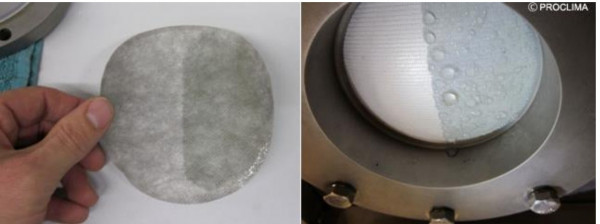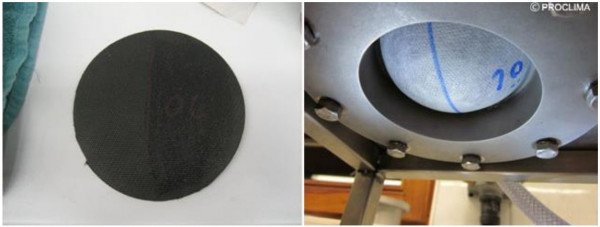Some exterior membranes for roofs and walls incorporate a monolithic thermoplastic elastomer ether ester (TEEE) film. The TEEE forms a weather resistive barrier (WRB) and when combined with weathertight sealing tape forms a permeable underlay system. These membranes, unlike conventional vapour permeable membranes, have no pores and are completely waterproof and wind/airtight. The membrane actively transports water vapour through molecular diffusion across the thickness of the TEEE film — an engineered property of this functional film.

Aren’t all vapour permeable membranes the same?
If vapour/water is present on the surface of the membrane, even the slightest differential in vapour pressure across the membrane (inside to outside) will promote vapour movement from one side to the other and dry out the moisture. Consequently, the membrane is very vapour open (0.4 MNs/g, 2.5 µg/Ns) in every condition.
Conventional vapour permeable sarking membranes and underlays depend on creating a microporosity in a normally vapour closed material (PE or PP). In the production process these materials are made vapour open by either spun bonding them into a PE mesh, puncturing the PP or stretching the PP with calcium carbonate CaCO3 additives in production. These micro-pores then allow gaseous water vapour molecules to be moved through the water-resistant layer by convection (leaking through the micro-pores).

By being porous, perforated or stretched, these materials are not 100% airtight. They are therefore vapour open because air and water-vapour molecules, driven by convection, leak through the micropores. Since the pores are quite small — nanometre scale — a relatively high vapour pressure differential is required for vapour to actually dry outwards through the pores. This is true even if the actual vapour permeance (per ASTM E96B) is high, which could be the case because the pores are big or perforated. If you can easily blow through the membrane when placing it over your mouth, the pores are probably large — very vapour open, and not very airtight, and possibly not even watertight under driving rain conditions.
Through active vapour diffusion, membranes with a TEEE film such as pro clima SOLITEX MENTO remain dry (as pictured above). In the same roof, the microporous membrane causes condensation to form, because passive vapour openness is not sufficient for outward drying.
The example above shows that actively vapour open membranes remain dry even when large amounts of humidity enter a roof enclosure with compromised interior airtightness. However, the conventional passively vapour open membrane in the same building is showing condensation — because water vapour wasn’t transported fast enough, causing a layer of condensate to build up. It looks like the membrane leaks, but the moisture is actually just interior humidity.
How is a vapour permeable membrane waterproof?
A micro-porous or perforated membrane is 'waterproof' because the surface tension in liquid water holds the drops together and prevents water beads from passing through the membrane. But if that tension is broken by surfactants such as oils, wood preservatives, wood tannins, soap or contaminants, the waterproofing becomes compromised.
By contrast, the monolithic film TEEE in membranes is completely waterproof. In the lab tests on one such membrane, pro clima SOLITEX MENTO, depicted below, to the left you can see the effect of applying oil to membranes before testing the water column (DIN EN 20811) of each membrane. The conventional membrane leaks at low water pressures, while SOLITEX MENTO membrane stays dry at a much higher column (notice the difference in bulge). This demonstrates that the waterproof qualities of the TEEE work even when exposed to surfactants such as oil.
The SOLITEX range uses a monolithic membrane and is waterproof (DIN EN 20811) up to lab test limitation of 10 metres head of water. Half of each membrane sample is coated with oil without any effect on waterproofness. Surfactant contamination on construction sites will have no effect on the water resistance of these products.
Microporous Membrane

Non micro-porous membrane

Preventing wind washing
ASTM E2173 test result shows that the material is so airtight that it exceeds the capabilities of the lab calibration — and goes above and beyond the Air Barrier Association of America (ABAA) requirements and certainly well above the thresholds specified in AS/NZS 4200.1 or NZS 2295 measured using ISO 5636-5 (AUS) & BS 6538.3 (NZ).
The TEEE functional layer is located in the middle of each product, providing active vapour permeability and waterproofing properties of the material. The SOLITEX product range allows exposure prior to cladding of: pro clima full scale weather testing in NATA and IANZ accredited laboratories has demonstrated world class weather tightness with the SOLITEX EXTASANA flexible membrane system and rainscreen cladding.
Three layers — each with its own function
Multi-layered products, such as pro clima WRB membrane systems, have specific properties in each layer to ensure excellent performance during installation and the life of the building.
In the case of SOLITEX MENTO, the top layer serves as a protective cover made with a PP microfibre fleece. This offers the external exposure resistance needed for both roofs and walls. When SOLITEX MENTO is used as a roof underlay, the top layer offers slip resistance, while also protecting the TEEE layer below.
The TEEE functional layer is located in the middle of each product, providing active vapour permeability and waterproofing properties of the material.
The TEEE functional layer also has the added benefit that it holds the product together, acting as a bonding agent. Applied in a high temperature process, it eliminates any need for hot melt adhesives and ensures excellent temperature resistance behind hot cladding materials.




























 Most Popular
Most Popular Popular Products
Popular Products


